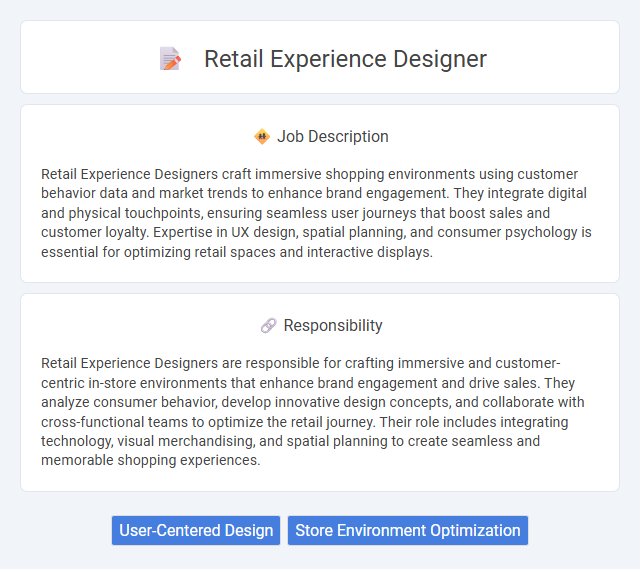
Retail Experience Designers craft immersive shopping environments using customer behavior data and market trends to enhance brand engagement. They integrate digital and physical touchpoints, ensuring seamless user journeys that boost sales and customer loyalty. Expertise in UX design, spatial planning, and consumer psychology is essential for optimizing retail spaces and interactive displays.
Individuals with strong empathy and creativity will likely find success as Retail Experience Designers, as the role demands understanding customer behaviors and crafting engaging store environments. Those who thrive in collaborative settings and adapt well to fast-paced retail dynamics are probably more suitable for this job. Candidates with a passion for combining visual design and user experience could be well-suited for the challenges this position presents.
Qualification
Retail Experience Designers require strong expertise in user-centered design principles, proficiency in design software such as Adobe Creative Suite and Sketch, and a deep understanding of consumer behavior and retail environments. Candidates must demonstrate skills in creating immersive, innovative customer experiences through spatial design, digital interfaces, and merchandising strategies. A background in graphic design, interior design, or human-computer interaction combined with experience in retail marketing or product development significantly enhances qualification.
Responsibility
Retail Experience Designers are responsible for crafting immersive and customer-centric in-store environments that enhance brand engagement and drive sales. They analyze consumer behavior, develop innovative design concepts, and collaborate with cross-functional teams to optimize the retail journey. Their role includes integrating technology, visual merchandising, and spatial planning to create seamless and memorable shopping experiences.
Benefit
A Retail Experience Designer likely enhances customer engagement by creating intuitive and immersive shopping environments, increasing brand loyalty and sales. Their expertise probably leads to optimized store layouts and personalized interactions, improving overall customer satisfaction. This role may also contribute to innovative digital and physical integration, strengthening the competitive edge of retailers.
Challenge
Retail Experience Designer roles likely involve the challenge of seamlessly integrating digital and physical shopping environments to enhance customer engagement. Balancing aesthetic appeal with functional design may require a deep understanding of consumer behavior and emerging technologies. The position probably demands continuous adaptation to shifting retail trends and competitor strategies to maintain a compelling brand presence.
Career Advancement
Retail Experience Designers drive innovation by crafting immersive customer journeys that boost brand loyalty and sales. Mastery in user-centered design, digital retail tools, and data analytics enables rapid promotion to senior design or strategic roles. Expertise in emerging technologies and consumer behavior insights accelerates career growth within retail and UX leadership paths.
Key Terms
User-Centered Design
Retail Experience Designers prioritize user-centered design principles to create seamless and engaging customer journeys within physical and digital retail spaces. By conducting in-depth user research and leveraging customer behavior data, they craft intuitive layouts and interactive elements that enhance shopper satisfaction and drive sales. Their expertise bridges the gap between consumer needs and retail business goals, optimizing experiences that foster brand loyalty and increase conversion rates.
Store Environment Optimization
Retail Experience Designers specialize in store environment optimization by analyzing customer behavior and spatial layouts to create engaging, intuitive shopping spaces that increase dwell time and sales. They apply principles of visual merchandising, lighting, and sensory design to enhance product visibility and evoke positive emotional responses, driving customer loyalty. Utilizing data-driven insights and innovative technology integration, these designers continuously refine store atmospheres to align with evolving consumer preferences and brand identity.
 kuljobs.com
kuljobs.com